Ann Arbor DDA Updates: Budget, TIF Talk
Ann Arbor Downtown Development Authority board meeting (April 4, 2012): The absence of four out of 12 DDA board members had no effect on any outcomes at the meeting, because the board did not have resolutions on its agenda.
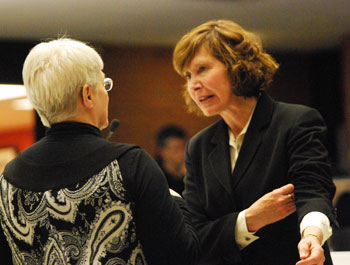
Before the Ann Arbor Downtown Development Authority's April 9 budget presentation to the Ann Arbor city council, DDA executive director Susan Pollay rolls up her sleeves as she chats with councilmember Marcia Higgins (Ward 4). (Photos by the writer.)
The meeting took place against the backdrop of the DDA’s budget presentation to the city council the following week – on April 9 – and various other ongoing projects. So the board’s agenda consisted of a collection of regular committee updates and status reports.
Those included an update on the Connecting William Street project – an initiative to explore alternative uses of a limited set of city-owned parcels currently used for parking. The DDA embarked on the project at the direction of the Ann Arbor city council in a resolution it approved about a year ago – on April 4, 2011. The DDA had wanted the ability to lead that exploration, partly in exchange for renegotiating a contract under which the DDA operates the city’s public parking system. That new contract was finally settled on May 31, 2011, and features a clause that provides the city of Ann Arbor 17% of gross revenues out of the public parking system.
Total parking revenues for fiscal year 2013 are projected at around $18 million in the budget approved by the DDA board at its meeting the previous month, on March 7, 2012. That budget was presented by the DDA at a city council work session on April 9. The budget presentation featured a review of the DDA’s history of infrastructure investment and impact on the downtown district since its formation in 1982 – over $100 million of DDA investment, accompanied by $300 million in private investment and an increase in taxable value from $89 million to $386 million.
Another work session highlight was a series of questions posed by councilmember Stephen Kunselman (Ward 3) about compliance with Ann Arbor’s ordinance that regulates how the tax increment finance (TIF) tax capture works for the DDA district. Last year, the city’s financial staff pointed to Chapter 7 of the city code, which appears to limit the amount of taxes the DDA can “capture” from the other taxing units in the district. The DDA board agreed with the city’s interpretation, and returned $473,000 in combined TIF revenues to the Ann Arbor District Library, Washtenaw Community College and Washtenaw County.
Subsequently, the DDA reversed its position and gave a different interpretation to Chapter 7. Responding to Kunselman at the work session, DDA board chair (and retired Washtenaw County administrator) Bob Guenzel told Kunselman that the DDA had informed other taxing units of the DDA’s revised position, which was not to say they agreed with the DDA, he said.
Also the focus of TIF monies captured by the DDA is a proposed development at 618 S. Main, which received a positive recommendation from the Ann Arbor planning commission on Jan. 19, 2012. The 7-story building would include 190 units for 231 bedrooms, plus two levels of parking for 121 vehicles. The developer of the project, Dan Ketelaar, has estimated that the tax on the increment between the current valuation of the property and the final built project would yield around $250,000 a year in TIF revenue to the DDA.
Ketelaar is was initially asking that in addition to reimbursement of certain costs (at around $1.4 million) within six months of the project’s completion, the DDA pledge 80% of its TIF capture money for six years – an additional $1.3 million – to support certain aspects of the project in connection with the state’s Community Revitalization Program. But subsequently, Ketelaar revised the request to include just the TIF reimbursement. So the total request, over six years, is $1.3 million. The CRP is the successor to the brownfield and historic preservation tax credit program. In order to approve the tax credit, the state would like to see a commensurate commitment from local units – and Ketelaar is proposing that it take the form of the DDA’s support.
Ketelaar has pitched his idea to the DDA board on several occasions now – first at the full board meeting on Feb. 1, 2012, and at three subsequent DDA partnerships committee meetings. DDA board members are cautious about the precedent that such a pledge might set, and the appropriateness of the DDA’s role at this early stage in the project. (Ketelaar has not yet acquired the land.) At the March 28 partnerships committee meeting, DDA board member Newcombe Clark expressed concern that, depending on the precise role defined for the DDA’s participation, the DDA could effectively be artificially inflating land values.
This report takes a look in more detail at Connecting William Street, the DDA’s April 9 budget presentation to the city council, the lingering TIF capture issue, and the 618 S. Main project, as well as odds and ends from the April 4 DDA board meeting.
April 4, 2012: DDA Board Meeting
The board’s meeting featured its usual updates related to the parking system, as well as one item that involves a project meant to find alternative uses to parcels currently used as parking facilities.
DDA Board Meeting: Parking System Report
An update on the performance of Ann Arbor’s parking system is a point of every DDA board meeting agenda. The DDA operates the public parking system under a contract with the city of Ann Arbor. The following week, on April 9, when Roger Hewitt presented the DDA budget to the Ann Arbor city council, he was asked about the parking system performance. Christopher Taylor (Ward 3) wanted to know the basis of Hewitt’s assertion that there was increasing demand for parking in the public parking system.
Hewitt appealed to the two data points that the DDA tracks for the parking system, and which had been presented at the DDA board meeting the previous week: Revenue is up, and hourly patrons are up. Revenue has increased around 16% ($1,362,989 in February 2012 compared to $1,173,568 in February 2011) and the number of hourly patrons is up around 5% (174,492 in February 2012 compared to 165,778). Hewitt told Taylor that the revenue increase outpaced the parking rate increase. Over the last two and a half years, here’s the data on parking revenues and patrons:
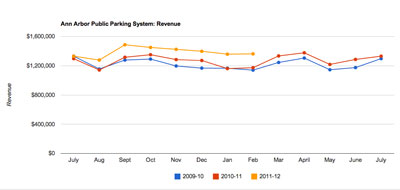
Ann Arbor public parking system revenue. Compared to February 2011, February 2012 showed a 16% increase in revenues. (Charts by The Chronicle from DDA data. Image links to higher resolution file.)
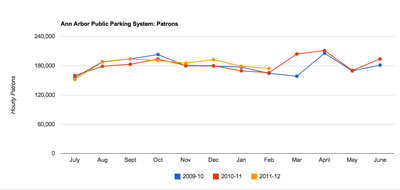
Ann Arbor public parking system hourly patrons in structures. Compared to February 2011, February 2012 showed an increase in the number of hourly patrons of about 5%. Due to leap year, there was one more business day for February 2012. (Charts by The Chronicle from DDA data. Image links to higher resolution file.)
DDA Board Meeting: “Library Lane Parking Structure”
During Hewitt’s presentation to the city council on April 9, he showed a slide referring to the new underground parking garage on Fifth Avenue as the “Library Lane Parking Structure” – picking up on the name for the new mid-block cut-through between Division Street and Fourth Avenue, which has been called “Library Lane” from the beginning of the project.
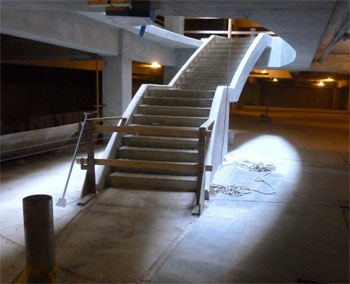
View from the bottom floor of the underground parking garage on Fifth Avenue in downtown Ann Arbor – the light is sunlight filtering down. The garage is nearly completed and is expected to be open at the end of June or the beginning of July. (Image is from a DDA slide presentation to the Ann Arbor city council on April 9, 2012.)
What’s somewhat new is the extension of that name to the structure. Susan Pollay, executive director of the DDA, told The Chronicle after the work session that for now the DDA will call it the Library Lane Parking Structure, but they would be sensitive to modifying that name depending on what people wind up calling it, after construction is complete and people start to use it.
At the April 4 DDA board meeting, John Splitt led off the regular update on the new underground parking garage with an allusion to the nice weather: “It’s a beautiful day to apply waterproofing.” He said the construction is moving along nicely – the concrete pours for the walls are complete, which means that the structural parts are now done, he said.
The surface waterproofing started a couple of weeks ago, Splitt said, and that’s the next step toward getting the surface concrete poured. Elevators have been installed, and the other mechanicals continue to be installed.
Splitt reported that the target date for re-opening Fifth Avenue is still May 20 – but he’s still saying Memorial Day (May 28). The garage itself is expected to be open by the end of June or the beginning of July.
DDA Board Meeting: Connecting William Street
At the April 4 board meeting, Joan Lowenstein gave an update on the Connecting William Street project – an initiative to explore alternative uses of a limited set of city-owned parcels currently used for parking. The DDA embarked on the project at the direction of the Ann Arbor city council in a resolution it approved about a year ago, on April 4, 2011. The DDA had wanted the ability to lead that exploration, partly in exchange for renegotiating the contract under which the DDA operates the city’s public parking system. That new contract was finally settled on May 31, 2011.
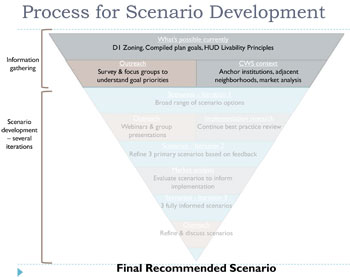
Scenario development process being used by the DDA for the Connecting William Street project. (Image links to larger resolution file.)
Parcels included in the area are: the Kline’s lot (on Ashley, north of William), Palio’s lot (at Main & William), the ground floor of the Fourth & William parking structure, the old Y lot (Fifth & William), and the top of the Fifth Avenue underground parking garage, which is nearing completion.
Lowenstein reported that a survey circulated to solicit input had generated around 2,000 responses whereas only 1,000 had been expected. Lowenstein characterized the clear message from the results as indicating a strong desire for a vibrant sidewalk experience in the William Street area, with attention to good building quality and design. She also said the results indicated a desire for economic development, housing and open plaza space. The full set of responses, including free responses, is available on the DDA website: Connecting William Street survey responses.
[By way of illustrating the responses to the survey (not meant to cover the range or complexity of the answers given) when asked to share additional extremely important goals for the project area, responses included: "MORE FRICKING PARKING!!!!!" and "Provide natural (i.e., 'green') open space as part of a broader design for public activity and use downtown."]
The DDA is partnering with Concentrate to host a speaker series, Lowenstein said, to explore ways to achieve some of the goals of the project. She called the first event a big success. The speaker was Dan Gilmartin, from the Michigan Municipal League, who has authored a book called “The Economics of Place.” She said the event was very well attended, with practically standing room only at Conor O’Neill’s on Main Street. The next speaker event will be on April 19 at 5:30 p.m. also at Conor O’Neill’s, she said, and will focus on activating sidewalk space. [The speakers will be Kirk Westphal, a member of the city of Ann Arbor planning commission, and Bob Gregory, president of the Detroit 300 Conservancy.]
Lowenstein also reported that the DDA’s leadership and outreach committee had worked with land-use economist Todd J. Poole of 4Ward Planning, who has already made a visit to Ann Arbor. Poole’s work is being funded by the grant that the DDA has obtained for the project, as part of a larger federal grant from the U.S. Dept. of Housing and Urban Development (HUD) to Washtenaw County.
Of the $100,000 Connecting William Street project budget, $65,000 will come from a community challenge grant awarded recently as part of a larger $3 million HUD grant received by Washtenaw County. The remaining $35,000 will be made up by DDA cash (no more than $20,000) and DDA in-kind contributions of staff time.
At the DDA’s partnership’s committee meeting on April 11, DDA planning and research specialist Amber Miller indicated that the report from Poole would be received around mid-May. She also described how the steps forward will include focus groups and the use of the survey results to start creating an initial iteration of scenarios. That work will take place in the context of understanding the significance of anchor institutions in the study area – the Ann Arbor District Library and the Ann Arbor Transportation Authority’s Blake Transit Center.
A final recommended scenario is expected sometime in August, Miller said, and that will be forwarded to the city council.
April 9, 2012: DDA at Council Work Session
At the DDA board’s April 4 board meeting, John Splitt noted that DDA board member Roger Hewitt would be delivering a budget presentation to the Ann Arbor city council at a work session the council was holding on April 9. Splitt encouraged other board members to attend.
By way of background, the DDA has in recent years not made such a budget presentation to the council. However, at a March DDA partnerships committee meeting, Ward 2 city councilmember Jane Lumm had asked about a possible presentation by the DDA to the council on its budget. Lumm serves as a city council representative to that committee. There was also support from other councilmembers for having such a presentation from the DDA. The DDA board had already approved its budget for fiscal year 2013 in March.
Council Work Session: DDA Background and Budget
The budget that Roger Hewitt presented to the city council at the work session was the same one that the DDA board had approved over a month earlier, at its March 7, 2012 meeting. It was prefaced by several slides reminding councilmembers of the impact the DDA has had on downtown Ann Arbor since its formation in 1982.
That includes over $100 million in investment by the DDA in various infrastructure, according to the DDA’s presentation. Also since 1982, the private sector has invested more than $300 million in downtown construction, which has added more than 3 million square feet of floor area. The DDA district’s taxable value grew from $89 million to $386 million over that period, Hewitt told the council.
Hewitt highlighted the fact that since the DDA took responsibility for management of the public parking system in 1996, two structures had received major repairs or renovations (Maynard, and Fourth & William) and another two had been demolished and rebuilt (Fourth & Washington, and Forest).
To that list Hewitt added the First and Washington structure, which needed to be demolished because it was failing structurally. The site is currently under construction by the developer Village Green, and will include a parking deck on the bottom floors of the City Apartments residential project – a parking deck the firm is developing in partnership with the DDA.
Highlights of the budget itself include:
FY 2013 DDA Revenues =========== $ 4 M TIF Capture $18 M Parking Revenue ----------- $22 M Total FY 2013 DDA Expenses =========== $ 6.7 M Debt Service $ 7.5 M Parking Operations $ 3.6 M Capital Costs $ 1.5 M Grants & Transfers $ 0.7 M Administration $ 0.4 M Professional Services & Insurance $ 0.5 M City Municipal Center Grant $ 3.1 M Parking Revenue (17%) to City ----------- $24 M Total
-
That difference in revenues versus expenditures means that the DDA will be tapping its fund balance reserve for around $2 million in the next fiscal year. As Hewitt explained to the council, this was a planned use of the fund balance and reflects the fact that the DDA is a capital-project driven organization. The pattern is to build up a fund balance in preparation for a project, which is then drawn down as projects are built. Hewitt told the council that the long-range planning is accomplished through a 10-year plan, which is updated quarterly.
Factoring in coverage of this year’s (FY 2012) use of fund balance and next year’s planned use of $2 million, the DDA will have a total fund balance of $4.38 million at the end of FY 2013, or an amount equal to about 18.2% of expenses [.pdf of FY 2013 budget]. Asked by Jane Lumm when the “floor” of the fund balance reserve will occur, Hewitt indicated that it would be this year or next.
By way of background, in the context of last year’s renegotiation of the contract under which the DDA operates the city’s public parking system, part of the DDA’s negotiating strategy was to point to its fund balance. The DDA warned that the contract terms the city wanted would lead to a precariously low fund balance in its 10-year forecast. The DDA board only agreed to the final term – a payment to the city of 17% of gross revenue from the public parking system – when the city of Ann Arbor agreed to backstop if the DDA’s fund balance fell below $1 million.
Council Work Session: Other Council Questions
Sabra Briere (Ward 1) wanted to know when the parking demand management, which the DDA had talked so much about, would be implemented. Hewitt told her that to some extent the DDA had begun to implement the pricing-by-demand model, but that it had really taken a backseat while the DDA completed the new underground parking structure on Fifth Avenue.
Briere also expressed her hope that the DDA would transition all the on-street parking meters to the kiosk-style electronic meters. Hewitt told Briere that if it were up to him, it would be done tomorrow. [The DDA had envisioned completing the transition, based on the positive results for the initial rollout of new meters in several locations. However, partly due to terms of the new parking contract with the city, the DDA has indicated that it does not have financial resources to make the upfront capital investment right now.]
Hewitt noted that about 70% of the payments made by new meters is via credit and debit cards.
Stephen Kunselman (Ward 3) expressed some dissatisfaction that the budget forwarded to the city council by the DDA did not include the “actuals” from prior years – like every other component of the overall city budget. Kunselman felt including those actual expenditures and revenues from prior years was a requirement of state law – that everything be in the same format. Ann Arbor’s chief financial officer Tom Crawford came to the podium and provided an assurance that the DDA figures from prior years could be provided.
Council Work Session: TIF Questions
Of the questions put to representatives of the DDA by the city council, those posed by Stephen Kunselman (Ward 3) about TIF capture were the most pointed. The basis of his questions can be traced back to an issue that arose a year ago, when the city of Ann Arbor financial staff pointed out the impact of the city ordinance that lays out how the DDA’s TIF capture is determined.
Council Work Session: TIF Questions – Background
A tax increment finance (TIF) district is a mechanism for “capturing” certain property taxes to be used in a specific geographic district – taxes that would otherwise be received by the entity with the authority to levy the taxes. So in the DDA’s TIF district, the DDA doesn’t levy taxes directly. Rather, a portion of the property taxes that would otherwise be collected by taxing units (like the library, community college and the county) is instead used by the Ann Arbor DDA for improvements within a specific geographic district, covering about 66 city blocks downtown.
What is the portion of the property taxes that is captured by the DDA? The captured tax is only that which applies to the difference between (1) the baseline value of the property when the district was first formed, and (2) the value of the property after new construction or improvements to the property. That difference is the “increment” in “tax increment finance.” Subsequent appreciation of property value due to inflation, after it’s been constructed or improved, is not included in the Ann Arbor DDA’s TIF capture.
Chapter 7 of the city of Ann Arbor’s city code lays out how the tax capture of the Ann Arbor DDA is limited, or capped. The mechanism used to cap the amount of tax that can be captured by the Ann Arbor DDA is the projected value of the increment in the TIF district, as laid out in the TIF plan – a required document under the state enabling legislation for DDAs (Act 197 of 1975). From Chapter 7 [emphasis added]:
If the captured assessed valuation derived from new construction, and increase in value of property newly constructed or existing property improved subsequent thereto, grows at a rate faster than that anticipated in the tax increment plan, at least 50% of such additional amounts shall be divided among the taxing units in relation to their proportion of the current tax levies. If the captured assessed valuation derived from new construction grows at a rate of over twice that anticipated in the plan, all of such excess amounts over twice that anticipated shall be divided among the taxing units. Only after approval of the governmental units may these restrictions be removed. [.pdf of Ann Arbor city ordinance establishing the DDA]
The TIF plan includes a table that lays out the projected valuation of the increment in the district, starting in 2003. The table includes three scenarios for the projected valuation: “realistic,” “optimistic” and “pessimistic.” They’re each based on a constant percentage increase each year. So the three different scenarios are generated from three different estimates of the percentage increase each year. [.pdf of DDA TIF plan appendix]
In May 2011, the DDA initially agreed that based on Chapter 7, the excess TIF money needs to be reimbursed to taxing authorities in its district, for excess TIF that had been captured since 2003. Those taxing authorities include the Ann Arbor District Library, Washtenaw County and Washtenaw Community College, and they were reimbursed a total of $473,000. The city of Ann Arbor was due to be reimbursed for $712,000, but the city council waived that amount.
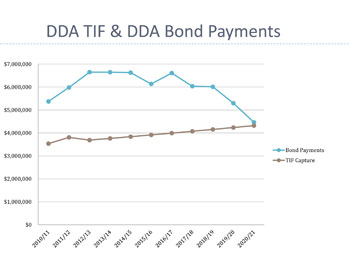
Ann Arbor Downtown Development Authority: Bond payments and TIF capture. (Image links to higher resolution file.)
Subsequently, the DDA reversed its legal position, and currently contends that Chapter 7 does not indicate a clear limit on its TIF capture and that the money it returned last year need not have been returned.
The DDA’s position on the Chapter 7 issue is reflected in a chart included in Roger Hewitt’s budget presentation to the city council.
The chart plots the DDA’s bond payments against its TIF revenues. The DDA contends that as long as its revenues from TIF capture (unlimited by Chapter 7) do not exceed its bond payments, it’s not required to apply the calculations in the ordinance – which last year were interpreted to place a limit on the amount of TIF money the DDA captured in the first place.
The DDA’s position relies on a subsequent portion of the ordinance, which reads [emphasis added]:
Tax funds that are paid to the downtown development authority due to the captured assessed value shall first be used to pay the required amounts into the bond and interest redemption funds and the required reserves thereto. Thereafter, the funds shall be distributed as set forth above or shall be divided among the taxing units in relation to their proportion of the current tax levies.
Complicating the issue is the fact that the bonds the DDA has historically used to finance parking structure construction and renovation have relied on revenue from the parking system – not TIF capture – to ensure that the debt service can be covered. [Editor's note: But see Comment 3 below] And it’s not the DDA that issues the bonds, but rather the city of Ann Arbor, which issues the bonds on behalf of the DDA. So in the DDA’s accounting system, the DDA itself does not maintain bond reserves. The DDA’s annual reports consistently show $0 for “bond reserve.” [.pdf of DDA annual reports from past years]
If Chapter 7 is interpreted to mean that any bond payments are first in line to be paid – before any other use can be made of TIF revenues – that could have an unintended impact on the DDA’s payment of roughly $500,000 a year to the city to support the new police/courts building, now called the Justice Center. The city uses that contribution from the DDA to help make payments on bonds it issued to build the Justice Center.
When Newcombe Clark was appointed to the DDA board in 2009, one of the first things he insisted on was to classify that police/courts payment to the city as a “grant” and not a “bond payment.” If it’s not a bond payment, then on the DDA’s current interpretation of Chapter 7, it’s not clear how the DDA could make that payment to the city out of its TIF revenues – because there would be other, outstanding debt that would have to be paid first, and there would not be any left over to make the $500,000 police/courts payment out of the TIF fund. However, the DDA could conceivably make the police/courts contribution from parking system revenues.
At the city council’s April 2, 2012 meeting, Kunselman had brought forward a resolution – which he could not persuade enough of his colleagues to pass. It would have directed the city financial staff to analyze the TIF capture according to Chapter 7, based on last year’s interpretation of the ordinance.
Council Work Session: TIF Questions – How Does this Work?
With that as background, Kunselman led off by asking whose responsibility it is to calculate the TIF. Hewitt told Kunselman that the DDA does not calculate the TIF capture.
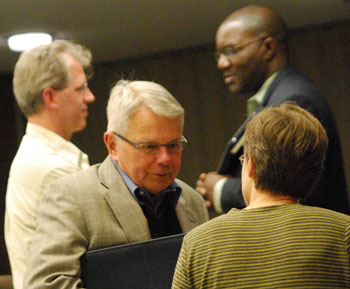
Before the start of the April 9 DDA budget presentation to the Ann Arbor city council. Foreground: DDA board member Bob Guenzel talks with Ward 4 councilmember Margie Teall. Background: Ward 3 city councilmember Stephen Kunselman talks with assistant city attorney Kevin McDonald.
Kunselman ventured that he had a different understanding, based on conversations with the city treasurer’s office. Hewitt deferred to Bob Guenzel, who is now chair of the DDA board. Guenzel served many years as Washtenaw County administrator until he retired in May of 2010.
In broad strokes, Guenzel explained that the DDA receives a check from the city of Ann Arbor treasurer’s office. Joe Morehouse, deputy director of the DDA, confirmed that’s how it works, from the DDA’s vantage point. Kunselman went on to raise the possibility that the DDA might need to be prepared to receive a different amount than the full TIF capture it had used to plan its FY 2013 budget – if the city treasurer were to reach a different conclusion than the DDA about how Chapter 7 applies.
Guenzel responded to Kunselman by summarizing the DDA’s legal position. As a legal matter, he said, the DDA believes that as long as there’s outstanding debt that exceeds the amount of the full TIF capture [as in the "DDA TIF and Bond Payments" chart], there’s no obligation to distribute TIF back to the other taxing units. Guenzel noted that the DDA had advised the taxing units in the district of the DDA’s position, which was not to say that those taxing units agreed with it.
618 S. Main Street
Related to TIF capture is the 618 S. Main project. Developer Dan Ketelaar is asking that the DDA use part of the TIF capture that would come from the new project to pay for certain elements of the project that he contends have a public benefit.
618 S. Main Street: Background, Proposal
The 618 S. Main project is a 7-story building, which would include 190 units for 231 bedrooms, plus two levels of parking for 121 vehicles. It received a unanimously positive recommendation from the Ann Arbor planning commission on Jan. 19, 2012. The developer of the project, Dan Ketelaar, has estimated that the tax on the increment between the current valuation of the property and the final built project would yield around $250,000 a year in TIF revenue to the DDA.
Ketelaar is was initially asking that in addition to reimbursement of certain costs (at around $1.4 million) within six months of the project’s completion, the DDA pledge 80% of its TIF capture money for six years – an additional $1.3 million – to support certain aspects of the project in connection with the state’s Community Revitalization Program. But subsequently, Ketelaar revised the request to include just the TIF reimbursement. So the total request, over six years, is $1.3 million. The CRP is the successor to the brownfield and historic preservation tax credit program. In order to approve the tax credit, the state would like to see a commensurate commitment from local units – and Ketelaar is proposing that it take the form of the DDA’s support. The costs for which Ketelaar is seeking reimbursement include various standard infrastructure components, green infrastructure components (for example, a rain garden for stormwater cleansing) and streetscape improvements from Mosley to just south of William Street.
Ketelaar has pitched the idea to the DDA board on several occasions now – first at the full board meeting on Feb. 1, 2012, and at three subsequent DDA partnerships committee meetings. Two of those committee meetings took place in March. Ketelaar and his team also discussed his proposal at the April 11 meeting of the partnerships committee. Ketelaar has a purchase option on the land through July, so he has an interest in seeing the financing for the project come together in the next few months. Based on partnerships committee discussions, the city council would prefer not to vote on the project until the issue of the state tax credits is finalized.
At the DDA’s April 4 board meeting, in reporting out from the downtown citizens advisory council (CAC), Ray Detter expressed support for the project, noting that both the CAC and the Old West Side Association strongly supported it. He said they wanted the project to be built. However, he cautioned that the CAC also supported consistent and careful planning. And he expressed caution about the DDA offering its support in the form that Ketelaar is requesting.
Detter pointed out that the CAC had been involved in creating the partnership process that the DDA has used in the past – for the first time in 1999. That had included support to Syndeco Realty, the development arm of DTE Energy, for the Ashley Mews project on Main Street. In all of the cases when the DDA had provided support, Detter said, the DDA had made sure to follow rules and procedures that were consistent and applied equally to all applicants. All those projects also involved some public benefit that might not otherwise have been achieved. So Detter stressed that the DDA should continue to insist that all DDA decisions on supporting 618 S. Main should be made based on the principles that the DDA has always supported. He wanted to make sure that no unfair precedent was set.
618 S. Main: History of DDA Project Support
By way of background, the board approved a $589,800 grant for the construction of pedestrian improvements associated with the Ashley Mews project, located at Main and Packard streets. The grant was for streetscape improvements along South Ashley and South Main streets, as well as on the pedestrian walk-through from Main to Ashley. The board also approved a $75,000 grant from its housing fund, to support affordable housing as a part of the project. [.pdf of Oct. 6, 1999 board minutes]
In his remarks to the DDA board at the April 4 meeting, Detter recalled the DDA’s support of the Ashley Mews project as well as other projects. Those include some that were eventually built, as well as some that were not ever built, he said. He mentioned the Village Green City Apartments project [which just recently started construction at First and Washington], Liberty Lofts [which completed construction in 2006 at First and Liberty] and Kingsley Lane [which was never built]. From a handout provided at a March DDA partnerships committee meeting, here’s a quick overview of the history of support to different developments made under the DDA’s partnerships program:
- 1999: Ashley Mews – $589,800 and $75,000. Reason: affordable housing/help the city of Ann Arbor sell Main & Packard.
- 2004: Kingsley Lane [not built] – 20% of the TIF for 10 years. Reason: first downtown residential project after greenbelt millage approval.
- 2005: Liberty Lofts – $600,000 ($300,000 for stormwater management, $250,000 for pedestrian improvements, $50,000 for parks). Reason: historic preservation/dense residential.
- 2006: William Street Station [not built] – 20% of the TIF generated over 10 years (maximum $500,000), waive meter bag fees (up to $100,000). Reason: help to preserve 100 very affordable housing units.
- 2007: Tierra on Ashley [not built] – 25% of the TIF generated over 10 years waive meter bag fees (up to $18,000). Reason: Platinum LEED construction.
In 2008, the DDA discontinued the partnerships grant program, because the board believed that development interest in downtown Ann Arbor was strong enough that such grants were no longer needed to help spur investment. [.pdf of March 5, 2008 DDA board resolution] From the board’s resolution:
Whereas, Development interest in the downtown is currently very strong, and the Partnerships Committee no longer believes that DDA Partnerships Grants are needed to foster development;
RESOLVED, The DDA resolves to eliminate its DDA Partnerships Grant Program, but will retain its other economic development tools to support downtown development including its facade loan program, provision of parking contracts, provision of parking assistance to lessen pedestrian impacts during construction and support for public infrastructure expansions.
Before discontinuing the grant program, the DDA has offered some support to two other projects, but not through that partnerships grant. And since the discontinuation of the program, the DDA has offered substantial support to one project – the Zingerman’s Deli expansion project at Detroit and Kingsley. The DDA voted on July 7, 2010 to support that project with an amount equal to the estimated amount of taxes on the increased value of Zingerman’s property, that the DDA would receive through its TIF capture for the first 15 years after the project is completed. That amount is $407,000.
The board approved the request from Zingerman’s by passing a resolution that specified “improvements to sidewalks and sidewalk curb ramps in the area near the Deli, providing additional wayfinding, providing funding for actual LEED certification costs, and providing contractor parking and staging …”
Here’s a summary of non-partnerships grant support to downtown projects:
- 2005: Denali/322 E. Liberty – 11 spaces in the South Fifth Ave. lot for 1 year (~$50,000).
- 2007: Mayer Shairer – reimbursement of $40,000 (fire hydrant).
- 2010: Zingerman’s Deli brownfield – $407,000 (for sidewalks, wayfinding, etc.). Reason: Jobs, anchor business, national attention.
618 S. Main: Review of DDA Board Discussion
At the DDA board’s April 4 meeting, Sandi Smith (co-chair of the partnerships committee and a Ward 1 city councilmember) reviewed the request that Ketelaar was making. She reported that there’d been a need to clarify how the DDA TIF capture works for Ketelaar’s project team. In calculating the total dollar amounts of TIF capture that the DDA would be pledging, the project team had factored in inflationary increases as a part of the increment on which the DDA could capture tax. The Ann Arbor DDA, in contrast to many other downtown development authorities, captures taxes only on the initial increment between the property value before improvements and the value after improvements. The DDA does not capture taxes on the additional value the property might accrue through inflationary pressures of the real estate market.

At the March 14 meeting of the DDA partnerships committee, Dan Ketelaar pitches his proposal for the DDA to support his 618. S. Main project.
Smith noted that the committee had reviewed the history of support that the DDA had given to projects and discussed whether 618 S. Main was an “extraordinary” project that the city needed and offered a specific public benefit. That discussion would continue, Smith said, at the next partnerships committee meeting. Part of the discussion, she noted, involves the project’s location in the South Main Street corridor.
At the partnerships committee meetings in March, as well as the committee meeting on April 11, after the board meeting, Ketelaar has stressed the location of the project as a key reason that the DDA should support it. It anchors the edge of the DDA district, could serve as a gateway to downtown, and has the potential to spur the revitalization of Main Street between Mosley and William along Main, Ketelaar says.
At the March 28 partnerships committee meeting – convened as a special meeting just to discuss Ketelaar’s proposal for 618 S. Main – Smith noted that the part of the proposal that resonated with her was the idea that the strip between Ashley Mews southward to the 618 S. Main location would become more attractive through making streetscape improvements. However, she expressed some hesitation about the timing, saying that she wished the DDA could take the time to make a plan for what that road should look like, so that it doesn’t get “piecemealed” together.
Also at that meeting, Newcombe Clark expressed concern that the “urgency” of the issue was being placed upon the DDA by the fact that Ketelaar’s purchase option for the land went only through July. He said he’d feel differently about it, if the land had already been acquired. Given that the land had not yet been purchased, Clark was concerned that the DDA’s support of the project could translate to artificially increasing the cost of real estate in downtown Ann Arbor. If Ketelaar’s project did not go forward, Clark wondered if there could be other developers lined up behind Ketelaar who’d be willing to purchase the land – perhaps for less than Ketelaar was offering – and to build a different project that did not require the kind of support Ketelaar was requesting.
There’d been some question about whether streetscape improvements for the entire stretch between Mosley and just south of William would be considered as a “local match” from the perspective of the state’s Community Revitalization Program. At their April 11 meeting, Nathan Voght, of the Washtenaw County office of community and economic development, indicated to the DDA partnerships committee that based on a conversation with a state official, he believed that the streetscape improvements would count for local match purposes.
Also at the April 11 partnerships committee meeting, DDA board members concluded they’d need to schedule another special meeting to continue the discussion of the 618 S. Main proposal. It will take place on April 25 at 9 a.m. The April 25 meeting will mark the fourth partnerships committee meeting that has featured the 618 S. Main proposal on its agenda.
Present (April 4 board meeting): Nader Nassif, Bob Guenzel, John Splitt, Sandi Smith, Leah Gunn, Keith Orr, Joan Lowenstein, John Mouat.
Absent: Newcombe Clark, Russ Collins, John Hieftje, Roger Hewitt.
Next board meeting: Noon on Wednesday, May 2, 2012, at the DDA offices, 150 S. Fifth Ave., Suite 301. [confirm date]
The Chronicle could not survive without regular voluntary subscriptions to support our coverage of public bodies like the Ann Arbor Downtown Development Authority. Click this link for details: Subscribe to The Chronicle. And if you’re already supporting us, please encourage your friends, neighbors and colleagues to help support The Chronicle, too!




Thank you for this careful review of the DDA grant/partnership process. I’m glad that the board is proceeding carefully with it. This is not the first time that Newcombe Clark has brought up some very good cogent points about DDA development support.
I’m generally pro-density downtown, but I have to hope that 618 S. Main falls through. It’s just so out of scale with the rest of the neighborhood, just like the Moravian etc. were. I’m not sure exactly where my intuitive boundary of downtown is, but it’s certainly north of Madison.
Actually, historically, the DDA DID rely on TIF revenues to finance parking structures. Those at Ann/Ashley and Liberty Square were financed with TIF because they were built before the DDA took over the management of the parking system (1992).